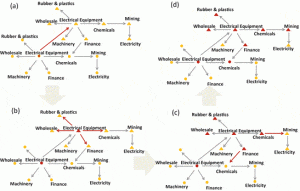Cascades of Failures in Interdependent Networks
We have so far learned information cascades in terms of diffusing certain information or certain behaviors throughout a network. We learned the mechanism behind how each individual’s behavior is influenced by its neighbors’ behaviors. However, this article examines the cascade of failures in interdependent networks. With the development of technology, the article argues that the dependency between networks is getting stronger and stronger. Hence, a failure of single node no longer results in small consequences but a sequence of failures of dependent nodes in other networks. We can already estimate, by intuition, the massive consequences of a failure in a real-world network if it were to happen. Here, the article formally describes the process of cascading failures in interdependent networks.
Suppose we have two networks A and B where nodes in A are dependent on the functionality of one or more nodes in network B and vice versa. An edge connecting Aj to Bi represents a dependency from node Aj to Bi. Therefore, if node Aj fails from malfunction or an external attack, the dependent node Bi would fail as well. We can remove directionality to the graph is there is all dependencies are two-way, but here, we assume the most general case where there is direction in dependency.
Now suppose failures occur in p fraction of nodes in A. The all nodes in B that were dependent on those failed nodes in A will fail as well. The failure of those B nodes will cause further failures in nodes in A and as a result, a cascade of node failures can occur, potentially creating a total failure in both networks.
The article also brings up the concept of clusters where due to the failed nodes, each network breaks up into clusters (connected components) of remaining active nodes. If we assume there is a threshold in which clusters small enough will become non-functional, there will be a recursive process of the failures that we described above.
The article also mentions real life examples of such failure cascades in interdependent networks. In quantifying and ranking the influence of industries and countries, we can apply the theory of cascading failures. Suppose there is a network of different industries in different countries. If industry A fails, other industries that depend on industry A to sell their products cannot sell to industry A anymore and thus they lose that much of the revenue. Suppose revenue for these industries reduce by p fraction and the threshold φ is the tolerance fraction above which an industry fails. Hence, we see that an industry fails if p > φ. We also assume that the failure of industry A in a country does not reduce the revenue of other industries in the country because they are able to quickly adjust to the change. Let us examine the figure below, representing the industries of two countries, Circle and Triangle.
Each arrow indicates a direction of money flow (a dependency). We see that the failure of electrical equipment in Circle causes a failure of the same industry in Triangle. The cascade continues until a steady state is reach in which all other industries’ p is less than φ and thus does not fail anymore.
We can directly apply to concept back to cascades of information failure. In simple terms, instead of diffusion the correction information, we can suppose malicious, or false information is being diffused. If enough of a node’s neighbors have the false information (above the threshold), then the node itself also contains the failed information. Hence, in the same way, information failure cascade can also occur. Especially because we also talked in class the diffusion of behavior across multiple clusters, or a Network of Networks (NON), the process described here describes a framework of cascading failures in such networks. One can imagine the catastrophic consequences that can occur if such cascade of failures were to occur in a real economic network or any other real-world complex network. This article highlights the process behind how such cascades work and show us a different way in which cascades in networks can work negatively for its nodes.


